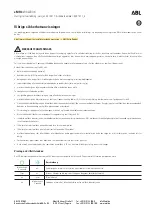
7. Connect the other end of the second
jumper cable to the engine hanger (as
shown). Do not connect this jumper
cable to any other part.
8. If your vehicle is connected to another
vehicle, start the assisting vehicle's
engine and increase its rpm slightly.
9. Attempt to start your vehicle's engine. If
it turns over slowly, make sure that the
jumper cables have good metal-to-
metal contact.
Securely attach the jumper cables clips so
that they do not come off when the engine vibrates. Also be careful not to
tangle the jumper cables or allow the cable ends to touch each other while
attaching or detaching the jumper cables.
Battery performance degrades in cold conditions and may prevent the engine
from starting.
What to Do After the Engine Starts
Once your vehicle’s engine has started, remove the jumper cables in the
following order:
1. Disconnect the jumper cable from your vehicle’s ground.
2. Disconnect the other end of the jumper cable from the booster battery (-)
terminal.
3. Disconnect the jumper cable from your vehicle’s battery (+) terminal.
4. Disconnect the other end of the jumper cable from the booster battery (+)
terminal.
Have your vehicle inspected by a nearby service station or a dealer.
A battery can explode if you do not follow the correct procedure, seriously
injuring anyone nearby.
Keep all sparks, open flames, and smoking materials away from the battery.
HANDLING THE UNEXPECTED
166 |
Overheating
Signs your engine is overheating:
• The temperature gauge needle is at the H mark.
• The engine suddenly loses power.
• Steam or spray comes out from under the hood.
• The message Stop Driving When Safe. Engine Temperature Too Hot appears
on the driver information interface.
First thing to do:
1. Immediately park the vehicle in a safe
place. Turn off all accessories and turn
on the hazard warning lights.
2. If no steam or spray is present: Keep
the vehicle running and open the hood
(See Under the Hood).
If steam or spray is present: Turn off the
engine and wait until it subsides. Then,
open the hood (See Under the Hood).
3. Check that the cooling fan is operating
and stop the engine once the
temperature gauge needle goes down.
If the cooling fan is not operating, immediately stop the engine.
4. Once the engine has cooled down, inspect the coolant level and check the
cooling system components for leaks. If the coolant level in the reserve tank
is low, add coolant until it reaches the MAX mark. If there is no coolant in
the reserve tank, make sure the radiator is cool, then cover the radiator cap
with a heavy cloth and open the cap. If necessary, add coolant up to the
base of the filler neck, and put the cap back on.
Once the engine has cooled sufficiently, restart it and check the temperature
gauge. If the temperature needle has gone down, resume driving. If it has not
gone down, contact a dealer for repairs.
If the coolant is leaking, contact a dealer for repairs.
Use water as an emergency/temporary measure only. Have a dealer flush the
system with proper antifreeze as soon as possible.
Continuing to drive with the temperature gauge needle at the H mark may
damage the engine.
HANDLING THE UNEXPECTED
| 167















































